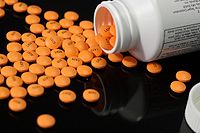
Photo from wikipedia
Introduction and objectives Despite their undoubted benefits, increased mortality is associated with overuse of short-acting β2-agonists (SABAs) and with using long-acting β2-agonists (LABAs) in the absence of inhaled corticosteroids (ICS).… Click to show full abstract
Introduction and objectives Despite their undoubted benefits, increased mortality is associated with overuse of short-acting β2-agonists (SABAs) and with using long-acting β2-agonists (LABAs) in the absence of inhaled corticosteroids (ICS). Mechanisms underlying these adverse effects are unclear. It has previously been reported that salmeterol and formoterol induce disease-relevant mediators in bronchial epithelial cells (BECs).1 We investigated whether other commercially available β2-agonists, or the short-acting muscarinic antagonist ipratropium, cause similar effects. Methods BEAS-2B BECs were stimulated with SABAs (salbutamol, fenoterol), LABAs (formoterol, indacaterol, olodaterol, vilanterol) or ipratropium at a range of concentrations or with vehicle control. Cell supernatants were harvested 24 hours post-stimulation. Additionally, BEAS-2B BECs were stimulated with salmeterol, with and without the corticosteroid fluticasone, in the presence and absence of rhinovirus-16. Cell supernatants were harvested 8, 24, 48 and 72 hours post-stimulation. Results Compared to vehicle control, there was significant induction of IL-6 by 100nM fenoterol (p=0.021), 1nM formoterol (p=0.015), 100nM indacaterol (p=0.049), 1nM vilanterol (p=0.029) and 0.1nM vilanterol (p=0.028); and significant induction of IL-11 by 10nM olodaterol (p=0.028) and 0.1nM olodaterol (p=0.012) versus vehicle-treated cells. There was no significant induction of IL-6 or IL-11 at any tested concentration of ipratropium (p>0.05). Compared to vehicle control, there was significant induction of IL-6 by salmeterol, both with and without rhinovirus-16, at 8, 24 and 48 hours (p<0.05); and significant induction of IL-11 by salmeterol alone at 24 and 48 hours (p<0.05) and by salmeterol/rhinovirus-16 co-stimulation at 48 and 72 hours (p<0.05) versus vehicle-treated cells. IL-6 and IL-11 induction was abolished at all timepoints upon salmeterol/fluticasone co-stimulation, with and without rhinovirus-16. Conclusions Clinically relevant SABAs and LABAs induce upregulation of asthma-relevant mediators in BECs. This effect is not exhibited by ipratropium. Inappropriate β2-agonist use may cause adverse effects in asthma via induction of, and augmentation of virus-induction of, the pro-inflammatory mediators IL-6 and IL-11 in BECs. ICS protect against this adverse effect. In vivo studies are required for further confirmation. Reference Ritchie AI, Singanayagam A, Wiater E, Edwards MR, Montminy M, Johnston SL. β2-agonists enhance asthma-relevant inflammatory mediators in human airway epithelial cells. Am J Respir Cell Mol Biol 2018;58(1):128–132.
Journal Title: Thorax
Year Published: 2019
Link to full text (if available)
Share on Social Media: Sign Up to like & get
recommendations!